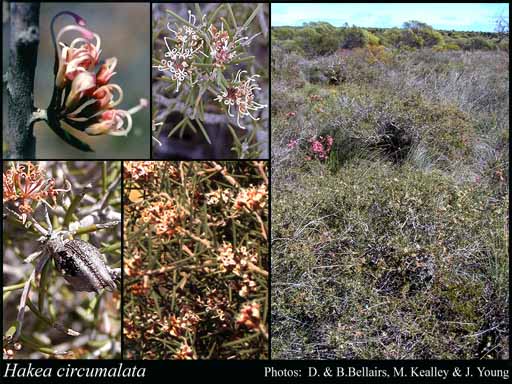- Reference
- Hooker's J.Bot.Kew Gard.Misc. 7:114 (1855)
- Conservation Code
- Not threatened
- Naturalised Status
- Native to Western Australia
- Name Status
- Current
Erect, open, pungent shrub, 0.6-1.5 m high. Fl. white & pink, Aug to Sep. White, grey or yellow sand, sandy loam, sandy clay, gravel.







Scientific Description
Shrubs, 0.3-1.5 m high; branchlets hairy. Leaves alternate, 10-35(-50) mm long, 0.9-1.7 mm wide, glabrous; lamina terete, entire. Inflorescences axillary or terminal, white or pink; pedicels 4-5 mm long. Perianth 4-6 mm long, glabrous or hairy; ovary glabrous; pistil 8-11.5 mm long, pollen presenter lateral, style glabrous. Follicles 15-25 mm long, 12-17 mm wide, corky tetrahedral projections (on external surfaces of fruit) absent; seed 14-20 mm long (including wing), 4-6 mm wide, the wing continuous. Flowers in July, August or September. Occurs in the Eremaean (ER) or South-west (SW) Botanical Province(s), in the Yalgoo (YAL), Geraldton Sandplains (GS), Avon Wheatbelt (AW) or Jarrah Forest (JF) IBRA subregion(s).
Distribution
- IBRA Regions
- Avon Wheatbelt, Geraldton Sandplains, Jarrah Forest, Yalgoo.
- IBRA Subregions
- Edel, Geraldton Hills, Katanning, Lesueur Sandplain, Merredin, Northern Jarrah Forest.
- IMCRA Regions
- Central West Coast.
- Local Government Areas (LGAs)
- Bruce Rock, Carnamah, Chapman Valley, Coorow, Corrigin, Dalwallinu, Dandaragan, Dowerin, Greater Geraldton, Irwin, Kellerberrin, Mingenew, Moora, Northam, Northampton, Shark Bay, Tammin, Three Springs, Victoria Plains, Wongan-Ballidu.